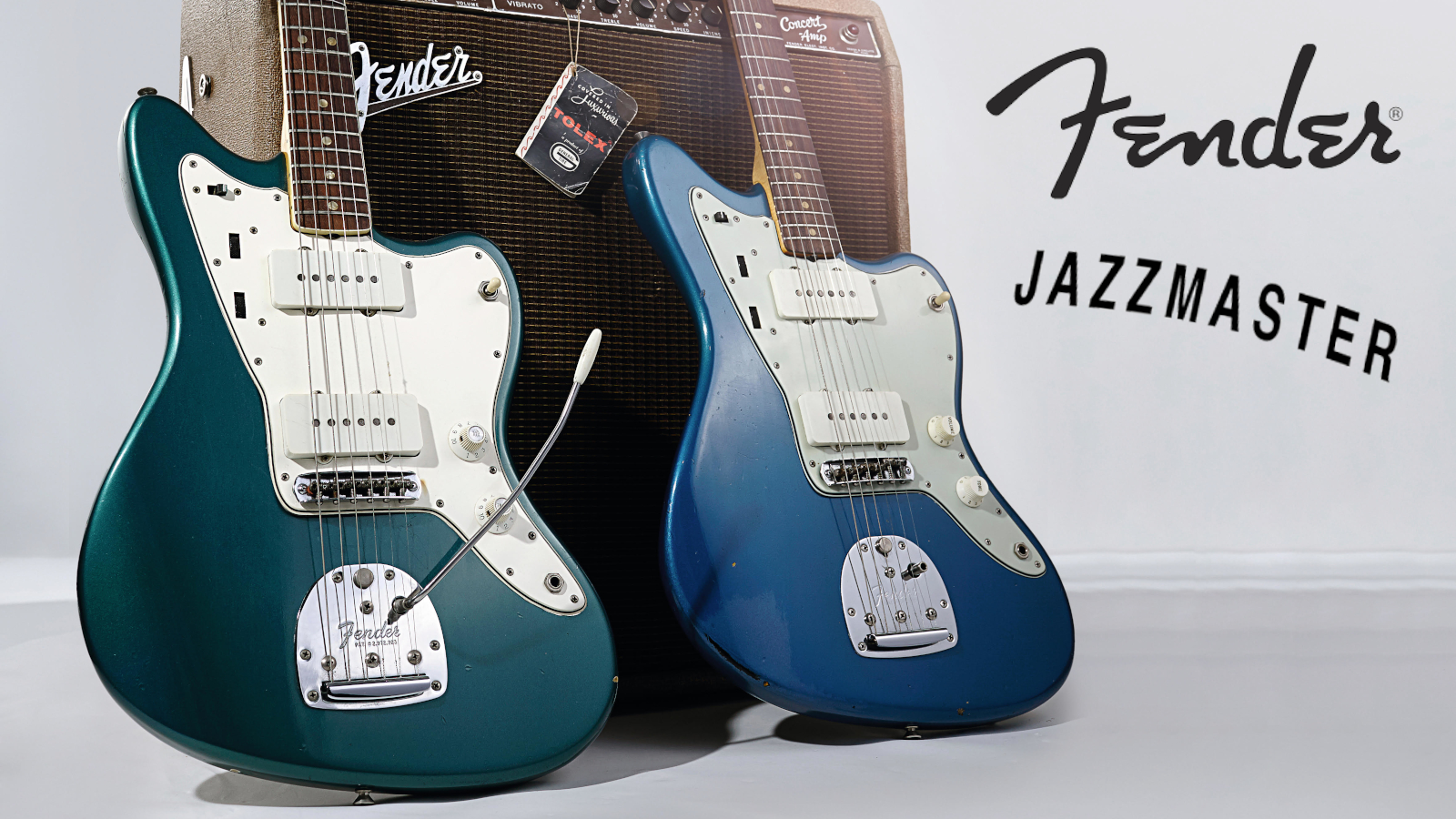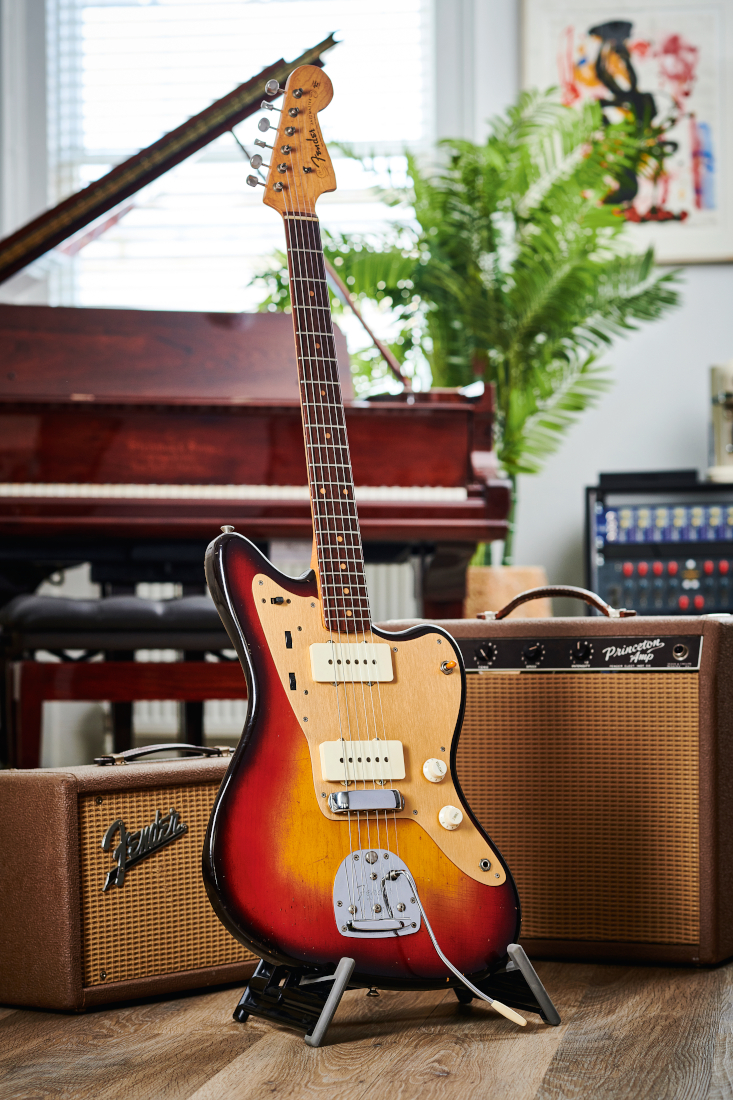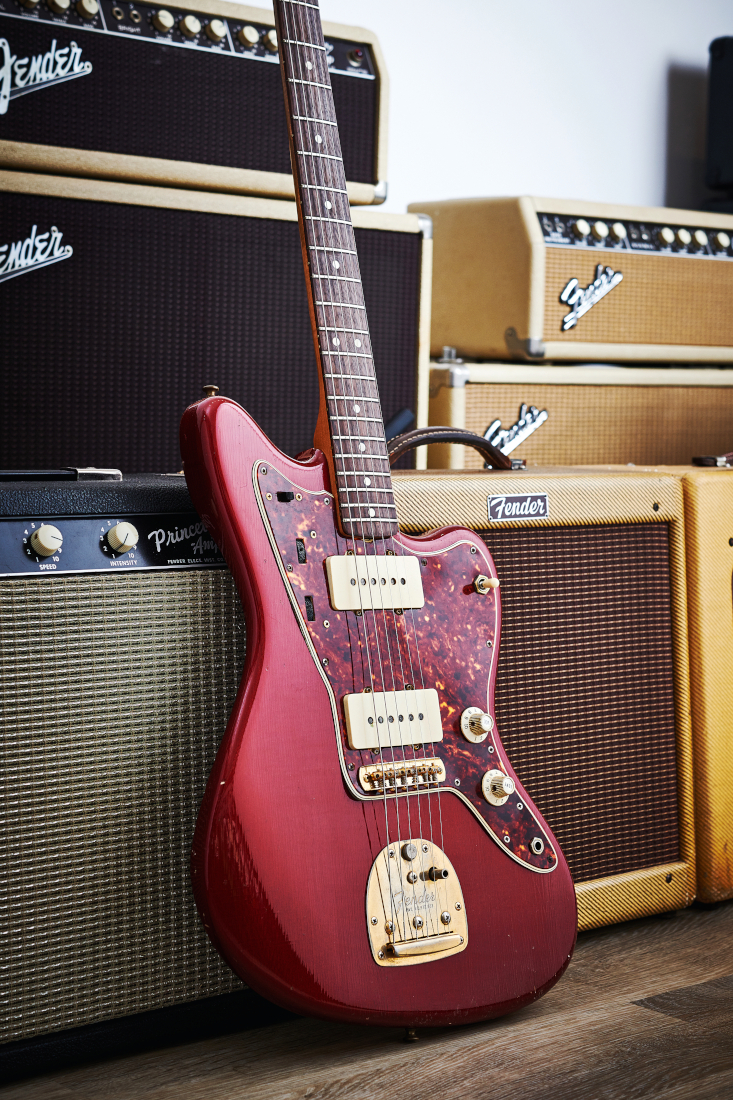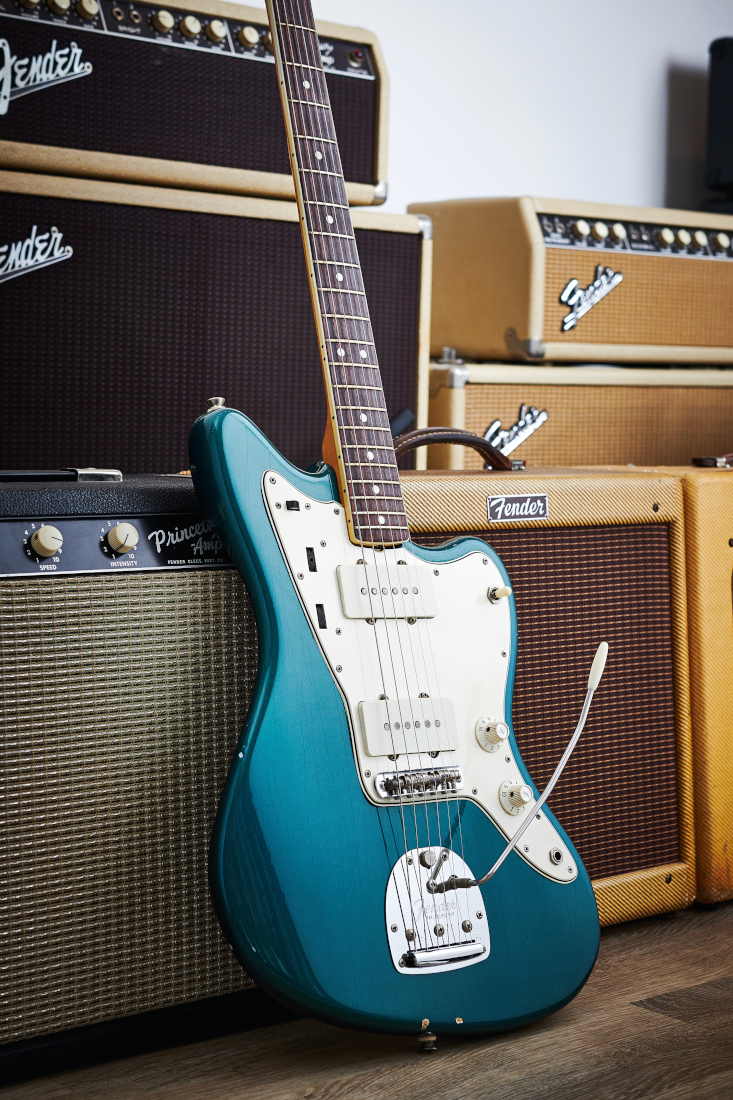The History of the Fender Jazzmaster
With the Jazzmaster’s underdog image rapidly fading into the past, we take a step back in time with Fender historian Terry Foster, and catch up with Mike Long, proprietor of vintage specialists ATB Guitars in Cheltenham, U.K., to touch on its future

Released as Fender’s top-of-the-line electric Spanish guitar in 1958, the Jazzmaster was an instant misnomer. Although it ultimately gained appeal as a workhorse jack-of-all-trades instrument, it was generally shunned by the masters of jazz. Pitting it against the company’s arch(top) rivals in the traditional jazz world was an ambitious move by Fender, given the long-established series of benchmark designs already set by Gibson, beginning in 1923 with the L-5.
“No more convincing proof of the extremely fine playing qualities and design features of the Fender Jazzmaster could be offered than its rapid acceptance and acclaim by guitarists throughout the country,” reads the Jazzmaster’s ’58 catalogue debut. Alas, for the likes of those bona-fide jazz players such as Barney Kessel, Tal Farlow and Johnny Smith, a great deal more in the way of “acceptance” and “convincing proof” was evidently required, as existing allegiances to Gibson continued into the ‘60s with the release of its new signature models.
“Fender failed to break into the jazz guitar market because it was already saturated,” explains Terry Foster, co-author of Fender: The Golden Age 1946-1970. “For the most part, the jazz guys – the players for whom the Jazzmaster was intended – were a bit more traditional. They already had the tools they required and they saw no reason to make the change. It didn’t work for them, even though the Jazzmaster mimicked some of the sounds of the big jazz boxes. [Fender] did everything possible and it fell flat.
“Also, back then, most guitar players had one guitar; they didn’t have an arsenal of instruments. I think they weren’t necessarily inclined to even try the Jazzmaster because they’d be worried about what people might think when they stepped on stage. Y’know, ‘Only a Gibson is good enough.’
“Whereas the rock ’n’ roll kids didn’t want their dad’s guitar, and the guys who played in Western swing bands were willing to experiment because it served a purpose; they were constantly on the road and they needed a hard-wearing [solid-bodied] guitar. These were the people who were willing to dress up in flashy clothes and were more inclined to try something new because they were generally less conservative than your typical East Coast jazz guy. Back then, if you’re using a Fender guitar, you’re probably a little more of a liberal-minded, forward-thinking kind of person because you’re willing to try something different. And if you bought a [custom color] Jazzmaster, you were really cut from a different cloth! It was a huge statement to be standing on stage with that.”

The genesis of the Jazzmaster began in early 1957 when Fender owned the country music end of the market and rock ’n’ roll was still in its infancy. Although the Precision Bass (released in 1951) had granted them a foot in the door, at that time, Fender was yet to tackle the electric jazz-guitar scene head on. “Electric bass was Fender’s first foray into jazz,” says Terry, “starting with blackguard Precision Bass players like Monk Montgomery and Shifty Henry, before the offset Jazz Bass arrived [in 1960]. The P-Bass cut across every musical genre and was a huge success in that regard. At that point, rock ’n’ roll was still part of the subculture and Fender largely ignored it – it didn’t factor into their marketing. It was more about Western swing and jazz players.
“The idea for the Jazzmaster came not from Leo Fender’s brain as such, but from the market itself via [Leo’s business partner] Don Randall. Don was a marketing genius and neither of these men would have been as successful individually without the other. They were two sides of the same coin and the Jazzmaster is a good example of the alchemy between them. Don was saying We need a jazz model. How do we get one into the marketplace?’ Leo didn’t make anything Don didn’t ask him to make, but, at the same time, he didn’t make something if he wasn’t interested.
All the latest guitar news, interviews, lessons, reviews, deals and more, direct to your inbox!
“There was constant feedback coming from the marketplace and they knew what was happening across the country in terms of popular music. Music styles were much more regionalized at that point in time, and although they lived in California, Don was always jetting off to the regional trade shows, so they would have seen how popular jazz was in New York, versus Western swing down in Southern California, Oklahoma and Texas.”

As the idea began to take root in Leo’s brain, work on Fender’s prototype jazz guitar soon commenced.
“In 1957, [factory manager] Forrest White got a little video camera, popped in some color film and walked through the factory,” recounts Terry. “There are several hours of original footage, but there’s a leaked clip online showing [musician/designer] Freddie Tavares sitting in Leo’s lab playing the first Jazzmaster prototype. It had a solid maple neck dated ‘5/57’ and the headstock is a little bit different. They didn’t normally make [fretted] maple neck Jazzmasters, but that neck was later sold on a normal ’58 production model and the prototype body is long gone.
“They eventually chose to use rosewood [fretboards] because that’s what was on the Gibson jazz guitars. And, by that time, they were having trouble with the finish on the maple necks wearing off. Their ideal was that musicians would just buy a new neck, but musicians tend to get very attached to them!
“That first prototype has the offset body shape, but the controls are completely different. It’s likely there were other versions beyond that, but who knows? Leo tended to destroy these things, or they were stolen out of the factory, or given away to employees. The Jazzmaster’s upper tone circuit was designed by Forrest White and came from a one-off lap steel he built before he worked at Fender – he showed it to Leo when he first came to Southern California. Leo was experimenting and trying to make the guitar sound like a big, fat jazz box. Those guys tended to roll off the tone and that’s what they were trying to mimic. He ended up using tone wheels instead of knobs, like he did on his original Fender Radio Service shop solid body guitar [made in 1943].”

Wound with Fender’s standard 42-AWG wire, the Jazzmaster’s bespoke dual pickups feature wide flat single coils that produce a slightly fatter, mellower, more jazz-like tone than that of a Strat or Tele.
“If you look at Gibson, most of their guitars used either P-90s or PAFs, but Leo usually had different pickups made for each model,” points out Terry. “Every guitar had its own voice. The pickups sometimes look the same, but they’re not, and I think Leo would have voiced them differently using a different number of winds.
“The original prototype pickup had eight polepieces [rather than the Jazzmaster’s six] and was a little narrower. They’re essentially the same basic design as the pickups in Fender’s [model 1000 and 800] pedal steel guitars that came out [in the late ‘50s], but they became two different types because the 1000 has two necks with eight strings and the 400 has one neck with eight strings.
“People sometimes forget about this kind of peripheral stuff that Leo was working on and how that influenced things. He scrapped the original design for the Stratocaster trem and started again from zero because it killed the sustain, but there may have been pieces of that initial idea that Leo brought back for the Jazzmaster, having had the time to refine it. The Jazzmaster [/Jaguar] trem system works perfectly, but Leo didn’t picture people dive-bombing like Hendrix. It was meant for a little bit of shimmer at the end of a chord and the odd note here and there. If you use it as intended, it doesn’t go out of tune and it works great.
“It’s the same thing with strings; if you put the right gauge strings on a Jazzmaster, it plays properly. With heavier strings on a Jazzmaster, nothing ever pops out, you can intonate it properly and it feels better – the whole thing starts to feel right.”

Although the Jazzmaster was never quite at home in the jazz world, its unique combination of specs and cutting-edge appearance meant it was soon adopted by the emerging surf-music scene of the early ‘60s. However, it was quickly overshadowed by the release of Fender’s new price-list-topping Jaguar model in 1962, further rendering it less able to find a musical niche of its own.
“In the ‘60s, the Jazzmaster’s lasting cultural impact was almost zero,” says Terry. “By the time the Jazzmaster was in the hands of surf bands, the Jaguar was out. People can argue that surf music had a cultural impact, but it was very much a sub-genre and those groups tended to be regional stars. Other than The Beach Boys, surf groups didn’t sell masses of records. And The Beach Boys weren’t really known for playing Jazzmasters anyway.
“The advertising at that time was more about the Fender brand in general and trying to capture the zeitgeist of the cool, forward-thinking youth market. That’s when they latched more onto youth culture generally, but the Jazzmaster was never intended for a teenager – it was intended for a pro player to be used in a pro setting.”
Jazzmaster production limped on throughout the hard-rock era of the ‘70s, but by the end of the decade it was all over: in 1980, it disappeared from Fender’s price list.

“You see so few ‘70s Jazzmasters around, but they wound the production down just as it was being discovered,” notes Terry. “You could argue that Elvis Costello and Tom Verlaine had an influence, but, again, that was part of the subculture. Things really started to change in the ‘90s. Collectively, we remember the ‘90s as a time when guys like J Mascis, Thurston Moore and Kurt Cobain were playing offsets – that probably drives part of the nostalgia for people these days.
“The prices of Jaguars and Mustangs went through the roof when Cobain started playing them. They rose exponentially overnight because Nirvana had a really broad cultural impact – they sold millions and millions of records in the US alone. One of the main reasons people bought Jazzmasters was because, like the Jags and Mustangs, they were cheaper than Strats and Teles, but there’s way more to Fender than Strats and Teles, and I think the offset Fender thing touches a lot of places now: price, the cool factor, a little bit of nostalgia, and the relative abundance of custom colors.”
“At the moment, vintage custom-color Jazzmasters are relatively inexpensive,” Mike Long, proprietor of ATB Guitars in Cheltenham, tells us. “If you were to try to find an equivalent-year custom-color Strat, you’d be paying a lot more money. Jazzmasters are still a bit of a bargain in the vintage marketplace.
When you plug into a Jazzmaster, it inspires you to head towards different territories with your playing. Which is what a great guitar should do
Mike Long, ATB Guitars
"Prices are going up, but they’re not reaching stratospheric levels. I’ve noticed the Jazzmaster increasing in popularity… People are more interested in them these days. Maybe people are cottoning on to the fact these are really cool guitars. They’re very versatile and you can do a lot with them.
“Guitars should inspire you to do things you don’t normally do. When you pick a Jazzmaster up, it’s a different feel to anything else Fender made, and it makes you play differently. It can break you out of a rut and inspire you to go further. I think the combination of body shape, pickups and trem gives it a unique sound and feel that makes you explore different tonal variations. When you plug into a Jazzmaster, it inspires you to head towards different territories with your playing. Which is what a great guitar should do.”
Guitar Player would like to thank Terry Foster, co-author of Fender: The Golden Age 1946-1970; Mike Long of ATB Guitars in Cheltenham, U.K.; and Vintage ‘n’ Rare Guitars in Bath, U.K.
Rod Brakes is a music journalist with an expertise in guitars. Having spent many years at the coalface as a guitar dealer and tech, Rod's more recent work as a writer covering artists, industry pros and gear includes contributions for leading publications and websites such as Guitarist, Total Guitar, Guitar World, Guitar Player and MusicRadar in addition to specialist music books, blogs and social media. He is also a lifelong musician.

